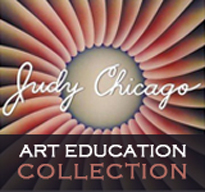Join the Dialogue Go to Dialogue
Judy Chicago: “Institutional Time: A Critique of Studio Art Education”
— keynote at Penn State, April 5, 2014, as part of the Judy Chicago Symposium: Planting a Feminist Art Education Archive. Hot off the press in March 2014, Chicago’s most recent book, Institutional Time: A Critique of Studio Art Education, is the focus of her lecture, in which she candidly reflects on her own teaching, and proposes ways that university studio art programs can be improved. Chicago’s personal narrative in Institutional Time questions unexamined assumptions about studio art education in higher education. In eye-opening transparency of institutional practice and jargon-free discussion, she contextualizes feminist theory, art history, and politics based upon five decades of research and experience. Chicago initiates a discourse toward an equitable, rigorous, and just system of studio art education.
Invitation from Judy Chicago
As part of the 2014 campus-wide, semester-long celebration of my art education archive at Penn State, a weekend long symposium was convened. During the symposium, I presented a lecture based upon my recently published book, “Institutional Time: A Critique of Studio Art Education”. My goal was to spark a long-overdue dialogue about university studio art education. Over the next months, sessions from the symposium—which were videotaped—will be posted on the Dialogue Portal, which is a new addition to my on-line art education archive. The first section of the Dialogue Portal includes my lecture, a video of my teaching, a series of questions that are intended to stimulate an on-line discussion, and Dr. Karen Keifer-Boyd’s multimedia presentation analyzing my teaching. This will be followed by an open live conversation with me on Saturday, October 25th at 11:00 a.m. EST. More information and registration for the real-time dialogue with me is linked here.
I invite you to watch my lecture, read the book (which is available as an e-book via Amazon and Barnes and Noble) and to watch Karen Keifer-Boyd’s multimedia presentation of my pedagogy, which represents the first effort to analyze my content-based pedagogy. I began to develop my pedagogical methods in the early 1970s when I developed the first feminist art program at California State University, Fresno, California. After a year, I brought my program and a number of my students to Cal-Arts, one of the premiere art schools in southern California. There, in tandem with the artist Miriam Schapiro, the Feminist Art Program produced “Womanhouse”, the first female-centered art installation, whose impact continues to reverberate.
Although I stopped teaching soon thereafter, I lectured and did workshops around the world where I continued to hone my pedagogy. As I describe in “Institutional Time”, in 1999, I returned to teaching, taking a series of semester long appointments at a variety of schools around the United States. Between 1999-2005, I taught at Indiana University, Bloomington; Duke, University of North Carolina, Chapel Hill; Western Kentucky University in Bowling Green; in a public/private partnership between Cal Poly, Pomona and the Pomona Arts Colony in southern California; and finally, at Vanderbilt. At the last three venues, my husband, photographer Donald Woodman, taught with me as part of my exploration of whether my pedagogy could be applied to men.
During these years, it became apparent to me that my approach to teaching was vastly different from what was taking place in most studio art education classes. Moreover, in my opinion – and as Stephen Henry Madoff (2009) pointed out in Art School: Propositions for the 21st Century “students are paying fortunes for … inadequate art educations” (p. 3). The 1970s ushered in a dramatic change in consciousness regarding gender and diversity but these changes have not yet been sufficiently translated into significant institutional change. I believe that there are many members of the art community who are dissatisfied with the state of university studio art education. I call on you to join me in a discussion about how to achieve a radical transformation of arts education in both policy and curriculum, one that will bring about bell hooks’ vision in Teaching to Transgress:
The classroom, with all its limitations, remains a location of possibility. In that field of possibility, we have the opportunity to labor for freedom, to demand of ourselves and our comrades an openness of mind and heart that allows us to face reality even as we collectively imagine ways to move beyond boundaries, to transgress. This is education as the practice of freedom (hooks, 1994, p. 207)
Excerpts from Judy Chicago’s teaching (1971-2005) can be seen in the video below, “Challenge Yourself: Judy Chicago’s Studio Art Pedagogy.”
References:
hooks, b. (1994). Teaching to trangress: Education as a practice of freedom. New York, NY: Routledge.
Madoff, S. H. (2009). Art school: (Propositions for the 21st century). Cambridge, MA: MIT Press.
- This forum has 7 topics, 84 replies, and was last updated 3 years, 6 months ago by .
- Oh, bother! No topics were found here.
- You must be logged in to create new topics.
